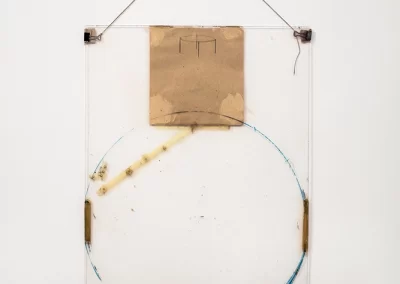ART WRITING
REVIEWS
Nahum Tevet
Art in America, December 2016
Although I have long been a fervent admirer of Nahum Tevet, until the recent exhibition “Nahum Tevet: Works on Glass 1972–1975” at Hunter College’s Bertha and Karl Leubsdorf Art Gallery, I knew of the work in question only through some tantalizing but indistinct period photographs. There is a certain irony in this because it is one of Tevet’s guiding principles, especially in his large-scale labyrinthine installations of recent decades, to create art that is resistant to the camera. But it also seems fitting that this body of work—stripped-down, small-scale wall pieces made from humble materials including tape, twine, wire, and wood scraps as well as glass and plexiglass—was accessible only via some dodgy black-and-white photographs, since at the time Tevet was making it, his primary access to the Minimalist and Post-Minimalist art, mostly American, that influenced him was through similar black-and-white images in art magazines.
For an artist working in Israel in the early 1970s, foreign magazines were practically the only way to access contemporary international art. Rather than lamenting his isolation or contenting himself with derivative production, Tevet, who didn’t travel abroad until 1975, embraced the differences between “center” and “periphery.” As he recalls in an interview in the exhibition catalogue, “You could not live in a relatively poor socialist kibbutz and pretend to be Donald Judd or Richard Serra.” Relying on cheap, readily available materials, Tevet began to assemble works in which conceptual self-referencing and inspired tinkering cohabit to an unusual degree. Like classic Conceptual art, each glass work is a record of its own making—one of the pleasures of the show was to watch a highly self-conscious artistic intelligence at work—but, somehow, they also seem to be achieved through improvisation and accident. This combination of the conceptual and the casual owes a debt to Tevet’s mentor, Israeli painter Raffi Lavie (1937–2007); it also makes Tevet’s work seem very contemporary, a precursor to much “provisional” art in its embrace of a self-questioning attitude and rejection of monumentality.
A typical glass work by Tevet involves a rectangle of roughly cut glass to which the artist has attached some metal binder clips. Lengths of twine usually run from one clip to another; sometimes the twine is used to suspend the work from a nail, and sometimes its role is purely formal. Frequently, small pieces of folded paper are wedged under the binder clips, while larger pieces of paper or card stock are held in place either by binder clips or by tape. The compositions are predominantly symmetrical, especially in regard to the placement of binder clips and twine, but there are significant departures from bilateral symmetry in how Tevet situates the larger pieces of paper. The palette is muted: manila paper, off-white masking tape, brown twine, black clips. The occasional spare image, such as a rectangle, circle, or schematic table, is drawn in pencil, wax pencil, or marker (the last nearly always black). The wall on which the pieces hang (white at Hunter) is left visible in most instances.
It’s tempting, and not unreasonable, to relate the fragility and Spartan qualities of the glass works to their historical context, especially the traumatic 1973 Yom Kippur War, in which Tevet served while working on the series. With its intricate play of hiding and revealing, the work is also conducive to epistemological interpretations. Equally compelling is the dialogue throughout the series between the mediums of painting and sculpture (in essence, Tevet proceeds by asking sculptural questions within the domain of painting). The show’s curator, art theorist Thierry de Duve, devotes a portion of his subtly argued catalogue essay to how Tevet responded to “Duchamp’s message” in this series, by which he means that Tevet had embraced the notion that anything can be art. In Tevet’s subsequent work, which to my eye represents one of the major sculptural oeuvres of the last thirty years, Duchamp is eclipsed by Constructivism, as refined handicraft and physical abundance supplant what the artist has called his “minimalist, puritan attitude” of the 1970s. One of the many stimulating challenges of this show was to locate signs of what lay ahead for the young artist.
